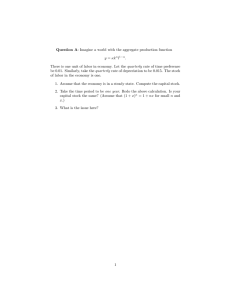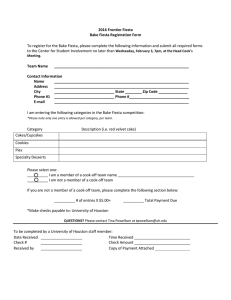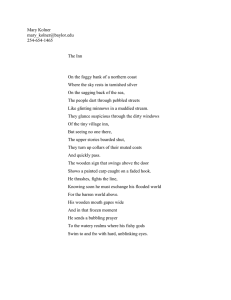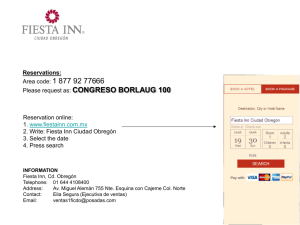BUILDING A HOtEL BRAND: HOw A BUSINESS
advertisement
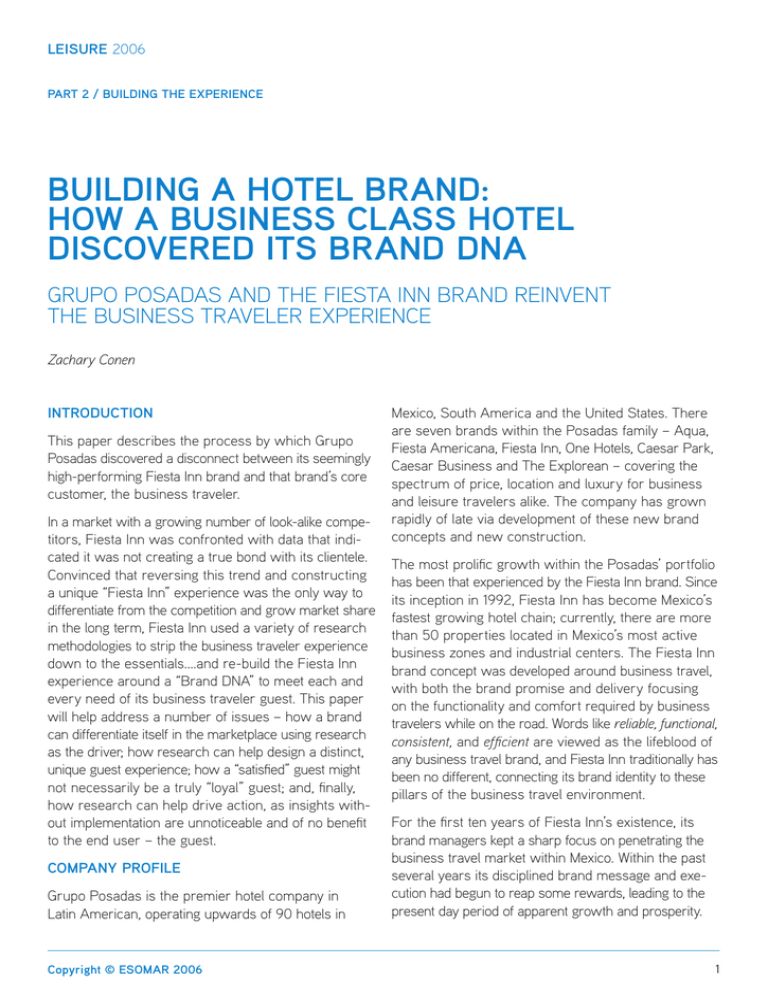
LEISURE 2006 part 2 / BUILDING THE EXPERIENCE Building a hotel brand: How a business class hotel discovered its brand DNA Grupo Posadas and the Fiesta Inn brand reinvent the business traveler experience Zachary Conen INTRODUCTION This paper describes the process by which Grupo Posadas discovered a disconnect between its seemingly high-performing Fiesta Inn brand and that brand’s core customer, the business traveler. In a market with a growing number of look-alike competitors, Fiesta Inn was confronted with data that indicated it was not creating a true bond with its clientele. Convinced that reversing this trend and constructing a unique “Fiesta Inn” experience was the only way to differentiate from the competition and grow market share in the long term, Fiesta Inn used a variety of research methodologies to strip the business traveler experience down to the essentials....and re-build the Fiesta Inn experience around a “Brand DNA” to meet each and every need of its business traveler guest. This paper will help address a number of issues – how a brand can differentiate itself in the marketplace using research as the driver; how research can help design a distinct, unique guest experience; how a “satisfied” guest might not necessarily be a truly “loyal” guest; and, finally, how research can help drive action, as insights without implementation are unnoticeable and of no benefit to the end user – the guest. COMPANY PROFILE Grupo Posadas is the premier hotel company in Latin American, operating upwards of 90 hotels in Copyright © ESOMAR 2006 Mexico, South America and the United States. There are seven brands within the Posadas family – Aqua, Fiesta Americana, Fiesta Inn, One Hotels, Caesar Park, Caesar Business and The Explorean – covering the spectrum of price, location and luxury for business and leisure travelers alike. The company has grown rapidly of late via development of these new brand concepts and new construction. The most prolific growth within the Posadas’ portfolio has been that experienced by the Fiesta Inn brand. Since its inception in 1992, Fiesta Inn has become Mexico’s fastest growing hotel chain; currently, there are more than 50 properties located in Mexico’s most active business zones and industrial centers. The Fiesta Inn brand concept was developed around business travel, with both the brand promise and delivery focusing on the functionality and comfort required by business travelers while on the road. Words like reliable, functional, consistent, and efficient are viewed as the lifeblood of any business travel brand, and Fiesta Inn traditionally has been no different, connecting its brand identity to these pillars of the business travel environment. For the first ten years of Fiesta Inn’s existence, its brand managers kept a sharp focus on penetrating the business travel market within Mexico. Within the past several years its disciplined brand message and execution had begun to reap some rewards, leading to the present day period of apparent growth and prosperity. LEISURE 2006 part 2 / BUILDING THE EXPERIENCE TOOLS TO MEASURE PERFORMANCE – FIESTA INN GROWS? For much of the first ten years of the chain’s existence, Fiesta Inn embarked upon a very fundamentally solid strategy for building the brand – target a customer segment, develop a brand promise and delivery of particular salience to that segment, and move to achieve “top of mind” status as the provider of choice to that segment. For Fiesta Inn, the target segment was the business traveler, and by most traditional measures, the strategy was quite successful. Hilton and Marriott. By 2004, Fiesta Inn had again moved the needle, narrowing the gap significantly between its “top of mind” scores and those of the two top performers – again, Fiesta Americana and Holiday Inn. In similar fashion, the ATP study tracked perceptions of the Fiesta Inn brand on six attributes deemed critical to business travelers.1 Not only was there a markedly positive perception in the marketplace of Fiesta Inn’s ability to deliver on all six attributes, but in all six categories Fiesta Inn’s scores equalled or exceeded those of Fiesta Americana and Holiday Inn (see figure 2). Fiesta Inn’s robust sales and growth numbers2 seemed to In 1999, Posadas began conducting its Advanced Tracking support the notion of a brand on the rise. Program (ATP) research for the Fiesta Inn brand, polling 220 business travelers every week on their awareness Likewise, the advanced analysis conducted on Fiesta of the business hotel landscape. Conducted by Millward Inn’s guest satisfaction and loyalty survey data also Brown, the research indicated that by 2002, Fiesta Inn painted the picture of a brand truly connecting with its had surpassed all but two brands (Fiesta Americana, intended audience and market segment. This analysis, conducted by a second research partner, LRA WorldHoliday Inn) in Mexico for “top of mind” awareness wide, Inc., indicated that 84% of the Fiesta Inn guest pool among business travellers (see figure 1); Fiesta Inn had could be classified as either “Customer Advocates” or outdistanced iconic brands such as Sheraton, Hyatt, Figure 1 TOP OF MIND Copyright © ESOMAR 2006 LEISURE 2006 part 2 / BUILDING THE EXPERIENCE Figure 2 MAIN ATTRIBUTES FOR BRANDS BUSINESS TRAVELLERS “Devoted Customers.” LRA arrived at its classifications by creating an index from the aggregated answers to questions concerning guest satisfaction, intent to return (loyalty) and intent to recommend (advocacy); only by rating Fiesta Inn highly in each of these “outcome” questions could a guest be included in the “advocate” or “devoted” segments. ASKING THE RIGHT QUESTION RAISES THE RED FLAG - “THEY LIKE US...BUT DO THEY LOVE US?” Despite all of these positive trends, the Fiesta Inn team – with the help of its research partners – identified some potential cracks in the brand armour. For one, a deeper analysis of the LRA guest insights report indicated that though 84% of the guest population Copyright © ESOMAR 2006 could be considered a “devoted” guest or better, only 36% had reached the highest classification of “advocate,” meaning the guest had given Top Box scores for satisfaction, intent to return and intent to recommend. Far from showering Fiesta Inn with distinction, this Loyalty Index metric placed Fiesta Inn firmly in the middle of the pack, as LRA’s Loyalty Index Benchmark for the hospitality industry was at 35%.3 For Fiesta Inn, the underlying message was that its guests liked them ... but didn’t necessarily love them and would potentially migrate to another offering if tempted. With this in mind, Fiesta Inn began to examine what it could do to upgrade the quality of its guest relationships from “like” to “love.” To explore this dynamic further, Fiesta Inn expanded its partnership with Millward Brown. Fiesta Inn re- LEISURE 2006 part 2 / BUILDING THE EXPERIENCE engaged Millward Brown for a type of study that would be able to delve deeper into the company-customer relationship; Fiesta Inn had first completed this type of study in 1999, and in 2003 Fiesta Inn launched its first “Brand Dynamics” study in five years. In Millward Brown’s words, the Brand Dynamics methodology: • Allows the client to identify the relationship that customers have with the brand and identifies the efforts that can potentially strengthen that relationship; • Explains why some customers are more loyal to a brand than others; • Measures the preferences for a brand and diagnoses the drivers of that preference.4 The metrics associated with the Brand Dynamics study were related directly to Millward Brown’s graphical construct of the Brand Pyramid (see figure 3). Each level of the Brand Pyramid represents a facet of the brand-customer relationship; moving up the pyramid from level to level indicates increased customer loyalty. The base of the Brand Pyramid is “Presence” (Is the Brand known?), followed in order by “Relevance” (Does the brand meet your needs at a fair price?); “Performance” (Does the product performance exceed expectations?); “Advantage” (Is the brand different from the competition, offering a rational or emotional advantage?); and, finally, “Bonding” (Does the brand offer a compelling advantage to make the customer feel ‘nothing beats this’?). The Brand Dynamics study was conducted via interview with 600 business travelers in the three most prominent Mexican business hubs – Mexico City, Guadalajara and Monterrey. The findings were to be presented as percentages of the respondents who fit into each level of the pyramid, with the natural expectation being that those percentages would decrease, as the threshold for inclusion would become more exclusive as one moved up the pyramid levels. Lastly, the percentage at each level was to be presented in comparison to an expected benchmark level for a company/brand of similar profile as Fiesta Inn. Improved performance in the upper reaches of the Brand Dynamics pyramid represented the transition from “like” to “love” that Fiesta Inn was seeking. Figure 3 WHAT IS A BRAND PYRAMID? Copyright © ESOMAR 2006 LEISURE 2006 part 2 / BUILDING THE EXPERIENCE Not surprisingly, Fiesta Inn’s performance in the study exactly mirrored Posadas’ strategy for building and positioning the brand in its first ten years of existence. As outlined previously, Posadas’ goals for Fiesta Inn had been to raise the awareness around the brand and build its reputation and capabilities around a very specific set of attributes with particular meaning to the functional needs of the business traveler. To that end, the cited research indicated tremendous progress towards those goals. In the Brand Dynamics pyramid, however, these more tangible, functional elements of the brand represented only the first three steps of the pyramid. Predictably, Fiesta Inn fared quite well within these foundational steps, particularly when comparing the results from the original study in 1999 to those in 2003. As one might have expected, Fiesta Inn’s rating for the initial step of the pyramid, “Presence” (i.e., the “Top of Mind” that they had been rigorously tracking in the ATP study), increased from 58% to 84%, a significant leap and a fairly impressive level of market awareness. Indeed, the Brand Dynamics study benchmark verified Fiesta Inn’s superiority in this regard, indicating that the chain was 24 percentage points higher in the category of “Presence” than would be expected of a brand of its size. The next level of the pyramid – “Relevance” – matched the image and attributes portions of the ATP study. Once again, the findings confirmed that Fiesta Inn had done an excellent job making its brand and the related offering relevant for the target business traveler market segment, as scores rose from 50% to 71%, placing Fiesta Inn five percentage points higher than the expectation benchmark. “Performance,” the third-level of the pyramid, jumped from 49% to 67%, reinforcing Fiesta Inn’s successful focus on delivering on the functional elements of the brand. Unlike the previous two steps, however, where Fiesta Inn exceeded the expected scores for a brand of its size, Fiesta Inn only matched the benchmark for “Performance.” It was Fiesta Inn’s scores for the final two levels of the pyramid – “Advantage” and “Bonding” – which Copyright © ESOMAR 2006 gave Posadas’ leadership real concern about a potential fissure in its relationship with guests. As a quick refresher, the final two steps of the Brand Dynamics pyramid represent the less tangible, more emotional elements of the customer relationship, with “Advantage” representing the question “is the brand different from the competition” and “Bonding” answering the question “yes it is – nothing beats it.” As with the previous stages of the pyramid, Fiesta Inn’s scores increased significantly in the final two as well5 on the strength of the brand’s overall development. Where a weakness began to reveal itself, however, was in Fiesta Inn’s expected performance against like brands; for both “Advantage” and “Bonding,” Fiesta Inn lagged behind the benchmark, by two and three percentage points, respectively. The most recent data from the Fiesta Inn Brand Dynamics study (and the related pyramid) was gathered and analyzed in May of 2005 and showed that the trends first identified in 2003 had only intensified. In this most recent iteration, Fiesta Inn showed its continued strength in advertising and operations (though the “Performance” ranking had slipped 2% beneath the expected target), but the levels of the pyramid representing the emotional connection with the guest had weakened in the ensuing two years. For the “Advantage” level, Fiesta Inn scored 63%, which now placed it 3% below the benchmark expectation; the “Bonding” measure dropped in real numbers to only 12% (from 15% in 2003), sliding to six percentage points beneath the standard for a brand of Fiesta Inn’s profile (see figure 4). What first arose as a statistical curiosity two years before had now grown into a disturbing trend – what did it mean to have “devoted” customers…if there was no real connection to the brand. Without commitment, was the relationship about “love” … or familiarity, the delivery of some basic needs and convenience? Further analysis of the data gathered via the LRA Worldwide guest satisfaction and loyalty tracking survey provided additional insight into this dynamic. As part of the strategic report, LRA conducted a “Segment Migration Analysis” in order to determine LEISURE 2006 part 2 / BUILDING THE EXPERIENCE Figure 4 which elements of the Fiesta Inn guest experience would have the most impact on “migrating” guests from “On the Fence” to “Devoted,” “Devoted” to “Advocate,” and so on (see figure 5). Two key drivers, representing attributes of the Fiesta Inn guest experience, recur throughout the analysis. These drivers, which related more to Fiesta Inn’s ability to emotionally – not functionally - meet the guest’s needs, were: • [Fiesta Inn’s] ability to effectively deal with your requests or solve your problems; • [Fiesta Inn’s] friendliness and courtesy to you. By the time the migration analysis focused on migrating the most loyal customer segments, these two drivers were isolated as the most important in Fiesta Inn’s ability to convert the “devoted” into “advocates.” This analysis served as a powerful complement to the Brand Dynamics study findings. Not only did Fiesta Inn have an issue in creating a true bond with its seemingly “devoted” guests, but the elements that would create that bond were less about the business traveler functionality that currently personified the brand and more about the interpersonal elements of the experience. CREATING THE FIESTA INN ARCHETYPE At first, these findings seemed counterintuitive to Posadas leadership; they had spent ten years building Copyright © ESOMAR 2006 a brand around all of the elements of a hotel stay that business travelers hold dear, and they had done it quite well. Now the research was indicating that their efforts had fallen short in creating a true connection with their guests, and that they needed to concentrate on building and strengthening that bond based on … emotions, guest interactions and service. At first glance, this strategy seemed more akin to that of a resort property. What Fiesta Inn quickly realized, however, was that there was more than one way to connect to a guest emotionally. While resort properties had been doing so for years, there might be a completely separate dynamic at play to connect with the business traveler on a higher level based on his/her unmet emotional needs. This revelation led Fiesta Inn to yet another partner, Mindcode Research, whose “…ethnographic and social anthropological research is designed to dig deeper than traditional research methods.”6 In August of 2005, Fiesta Inn engaged Mindcode to conduct a study based less in quantitative data and more in the ethnographic and anthropologic relationship between the brand and its users. To elicit this qualitative data, Mindcode conducted in depth interviews with both male and female business travelers between the ages of 28 and 65 years in Mexico City, Guadalajara and Tijuana. In addition, Mindcode spent some time observing guest activities and interactions at several Fiesta Inn LEISURE 2006 part 2 / BUILDING THE EXPERIENCE Figure 5 SEGMENT MIGRATION ANALYSIS properties, fulfilling one of the key components of ethnographic research – observing the “subjects” in their “habitat.” The goal of this effort was suitably ambitious – to “understand” business travelers by developing a universal profile that would capture their needs, fears and preoccupations and how to respond to them appropriately. What Mindcode found was that it was incomplete to think of the business traveler exclusively in his/her role of “executive.” More accurately, the business traveler played two roles while on the road and staying at a Fiesta Inn. The first role, of course, was that of an “executive;” the second role was that of a “person”. While the latter role seems self-evident, Fiesta Inn quickly realized that the brand had been neglecting the “person” within the business traveler. Mindcode expanded further on this concept, building out the profile of the business traveler who was both executive Copyright © ESOMAR 2006 and person, using a universal male pronoun as the personification of the business traveler in question. He has an objective; his responsibilities continue even if he’s out of the office. The emotional implications of this reality are that his primary concern is a sense of continuity in his travels that will allow him to accomplish his business goals. Because he is on the road, his “safety net” has been altered and needs to be rebuilt under new conditions, making him vulnerable, dependent and tense. What does he value? Efficiency, attention and a sense that “they understand.”7 For Fiesta Inn, the mandate from this portion of the profile was clear – how do you replicate that “safety net” within the hotel environment? And on a more functional level, how do you shift your traditional thinking from “meeting the needs” of your guest to that of “contributing to his/her success?” LEISURE 2006 part 2 / BUILDING THE EXPERIENCE For the “person” role within the business traveler, the dynamic that Mindcode identified was perfectly intuitive...but had typically been removed from the equation where business travel was concerned. For the “person,” the emotions identified came to bear generally upon completion of the activities associated with the “executive” role: At the end of the day, they miss the contact they have with their loved ones at home. They long for the fragments of their lives that are comfortable, familiar and soothing – food, bed, a warm reception. They also feel anonymous.8 Ironically (or perhaps intentionally), for this summary of the more interpersonal emotional needs of the business traveler, Mindcode abandoned the masculine pronoun and went with the gender-neutral “they.” The picture that accompanies the summary, of course, is of a woman. In any case, the direction provided by this portion of the profile was equally instructive – Fiesta Inn needed to convey that not only are “we here to serve you...but we care about you,” fulfilling the need to be known, recognized and ensconced in a “familiar place.” With this information in hand, Mindcode had created a vivid picture of the type of experience Fiesta Inn guests (and business travelers in general) were craving. The challenge at this point became less one of discovery and more of communication and implementation. Having isolated the different “feelings” that business travelers were seeking from Fiesta Inn and incorporating them into an overall profile, how could Mindcode help Fiesta Inn evolve into a brand that could deliver those “feelings” consistently? Fiesta Inn had always been a brand focused on raising awareness and the delivery on a very functional set of needs. The crucial next step for elevating the brand and creating customer loyalty was to weave something far more ephemeral into the brand DNA – the ability to deliver a “feeling.” To that end, Mindcode began assembling a collection of figures within the life of a hypothetical business Copyright © ESOMAR 2006 traveler (Mr. X) who may have fulfilled the expressed needs at some point within other aspects of Mr. X’s life. From Mr. X’s business dealings, Mindcode posited that an executive assistant would fill the needs articulated in the profile; at home, the identification was with more of a mother figure; in healthcare, a nurse, and so on. With these figures bringing to life the types of people who provide these “feelings” in one’s everyday existence, Mindcode was able to identify the common thread throughout and designate a persona – or, more accurately, an archetype9 - for the evolution of the Fiesta Inn guest experience. In other words, if Fiesta Inn were a person, what type of person might it be? The archetype that Mindcode identified as the new representation of the Fiesta Inn brand: “Caregiver.” THE DEVELOPMENT AND COMMUNICATION OF THE “CAREGIVER” ARCHETYPE In order to fully develop the Caregiver archetype, Mindcode created a wealth of materials to illustrate the attributes within the archetype and tie them to examples of real life behaviors and actions. This step was crucial, as it enabled Fiesta Inn to bridge the gap between the research findings, the actual implementation of an enhanced guest experience, and the needed changes on the property level. While the process itself that Fiesta Inn had undergone was somewhat revelatory, the information that it yielded would not have been actionable without a meaningful way to translate it into actual behaviors to model and experiences to deliver. To assist Fiesta Inn in the further development and communication of the caregiver archetype, Mindcode created a diagram titled “A Caregiver Anatomy” (see figure 6). The anatomy outlined the path from the needs (emotional, functional and symbolic) that the caregiver fills; to the interpersonal qualities and actions of the typical caregiver (empathy, compassion, willingness to go the extra mile); to the meaning of a caregiver’s actions (“giving to others”); to examples of caregivers in society (teacher, doctor, fireman); to the ultimate “feeling” that a caregiver provides – “you are taken care of when you’re with me.” LEISURE 2006 part 2 / BUILDING THE EXPERIENCE Figure 6 UNDERSTANDING THE ARCHETYPE: A CAREGIVER ANATOMY As an illustrative follow-up to the anatomy diagram, Mindcode prepared a presentation to introduce the caregiver archetype to all Fiesta Inn personnel. The presentation, which would ultimately be delivered to each and every Fiesta Inn employee, actually showed examples of those who embodied the caregiver role and why, both inside and outside the context of a hotel environment. For example, one slide pictured a fireman on a rescue, indicating the presence of the caregiver archetype when one takes risks for others; a second slide showed a parent helping a child with homework, noting that the caregiver archetype is present when one is patiently and selflessly interested in helping another achieve positive results … knowing full well there will be no gratuity at the end of the interaction. Finally, the presentation connects each and every role (front desk, food and beverage, housekeeping, Copyright © ESOMAR 2006 etc.) within the hotel to the practical execution of what “caregiver” actually means in the hotel environment. While there was no expectation that employees would begin modeling the new archetype immediately, these efforts were crucial to introduce the new concept and make an initial connection to the workforce – those who would be charged with embodying the archetype on a daily basis. TAKING ACTION – IMPLEMENTING THE ARCHETYPE As a transition between the archetype development/ communication stage of the process and the implementation stage, Fiesta Inn began the process of shifting both its internal and external branding messages. Internally, Fiesta Inn immediately began reinforcing the concept of “caring,” adopting the Spanish phrase “Pensamos LEISURE 2006 part 2 / BUILDING THE EXPERIENCE en la Gente que Trabaja,” which translates to “We Care for Working People.” For the external message, Fiesta Inn shifted slightly, anticipating that some potential customers, no matter how much they might actually crave it subconsciously, probably didn’t view themselves as needing “care.” With this in mind, the Fiesta Inn team crafted an external message that married both the “executive” and “person” roles they had identified within the business traveler: “Donde Descansa la Gente que Trabaja,” or “Where People that Work can Relax.” areas. New furniture, bath amenities, bed, magazines, etc., all selected to elicit the feeling of being cared for... in a home environment and fulfilling the caregiver archetype for the senses of touch and sight. Once the facilities have been refreshed in this manner, Fiesta Inn plans to address the other senses via a more subconscious evocation of the caregiver, with music and scents (vanilla, mint, camomile) carefully selected and tested to put the business traveler in the desired state of mind for success...and relaxation. With the shift in messaging came a focus on implementing the elements of the guest experience that would bring the archetype to life. In June of 2006, Fiesta Inn unveiled the first phase of the implementation, which would address the products or services that Fiesta Inn could offer to show the guest genuine interest and support. This phase came in the form of a “10 Step” program oriented around each of the “touch points” of the guest experience deemed most important by the LRA Worldwide guest satisfaction and loyalty tracking survey. The “10 Steps” addressed bodily/energy needs such as food and beverage service;10 emotional needs such as stress reduction;11 and needs that would contribute to the guest’s success as an executive.12 These measures were rolled out during the summer of 2006, with compliance with the new archetypical standards required by late 3rd Quarter 2006. To ensure compliance, Fiesta Inn integrated the new standards into its site inspection protocol that is part of the larger Posadas Prometeo Quality Assurance/Brand Assurance program conducted by LRA Worldwide. As LRA consultants visit and evaluate the guest experience at each Fiesta Inn property during the 3rd and 4th Quarter of 2006, the expectation is for the new caregiver “10 Step” program to be in full effect. CONCLUSION The next implementation phase of the caregiver archetype is scheduled for 2007, and is focused less on the service attributes and more on the full sensory experience that will animate the caregiver archetype. The first measures are more tangible, and call for an overhaul of the Fiesta Inn guest room and common Copyright © ESOMAR 2006 Fiesta Inn’s holistic approach to studying its guest experience ensured that there were no shortcuts on this journey to remake the Fiesta Inn brand from the inside out. By embarking on the journey via a process of: a) assessment of the “current state” of the guest experience; b) identification and design of the desired “future state”; c) implementation of the guest experience elements; and d) measurement of the experience delivery, Fiesta Inn is creating the best environment to truly effect change across its portfolio and impact guest loyalty. To truly recalibrate the “Brand DNA,” it was crucial for Fiesta Inn to: [concentrate on more than just] sheets, pillows and gadgets. Lodging brands that are truly committed to pulling off this paradigm shift are seeking ways to redesign the entire guest experience to elicit that homespun feel. Property design, room layout and service models are all being reworked to align around the concept of hotel as home. Without this alignment, the desired experience is in grave danger of being only duvet cover deep, thereby alienating guests.13 By proceeding methodically through the process as described in this paper, Fiesta Inn created the “alignment” referenced in the citation above. While the first wave of measurement to indicate the fruits of their labors will reach Fiesta Inn leadership in the 4th Quarter of 2006, there is some satisfaction on the part of the company for having recognized the opportunity and stalked it methodically and logically 10 LEISURE 2006 part 2 / BUILDING THE EXPERIENCE via a variety of research methodologies and activities. Only time will tell, however, if the typical Fiesta Inn guest is stuck on “like”....or if the implementation of the caregiver archetype has created a true love match. Footnotes 1. Those attributes were: 1) Good Frequent Guest Program; 2) Guest Rooms that Allow Guest to Work Comfortably; 3) Features Best Promotions for Business Travelers; 4) Casual and Flexible Ambiance; 5) Good Support for Business (i.e., fax, meeting rooms, etc.); 6) Recognition as a Business Class Hotel. 2. From 2001 to 2004 Fiesta Inn grew from 29 to 47 properties. In 2001 the brand experienced a 19% growth in sales from 2000; in 2004, the figure was a 51% growth in sales from 2000. 3. LRA Worldwide’s Loyalty Index benchmark is based on more than 350,000 guest survey data points. 4. www.millwardbrown.com 5. The “Advantage” scores moved from 34% in 1999 to 56% in 2003; the “Bonding” scores from 4% to 15%. 6. www.mindcode.com 7. Mindcode Brand Research Presentation to Grupo Posadas/ Fiesta Inn, August 2005 8. Ibid. 9. http://www.m-w.com/dictionary Main Entry: ar·che·type. 1: the original pattern or model of which all things of the same type are representations or copies: PROTOTYPE; also : a perfect example 10. Examples: Free coffee and cookies for early-risers who leave before the kitchen opens; 24-hour room service; extended menu options and service hours. 11. Example: The check-in process was revised to ensure that the front desk clerk immediately reassured the guest that his/ her room was available, eliminating the stressful phase of the check-in where the clerk would peck away at the reservations computer without any communication and/or validation that the room was waiting without problem. 12. Examples: Implementation of a mandatory 24-Hour Business Center; Creation of a corporate resource guide for the Guest Services Directory; Creation of the “May We Help You” button option on the phone system across the portfolio. 13. Rush, Rob. “There’s No Place Like Home: The New Paradigm of Hotel as Home,” Hotel Business Review: August 2006. The Author Zachary Conen is Director of Marketing, LRA Worldwide, Inc., United States. Copyright © ESOMAR 2006 11
